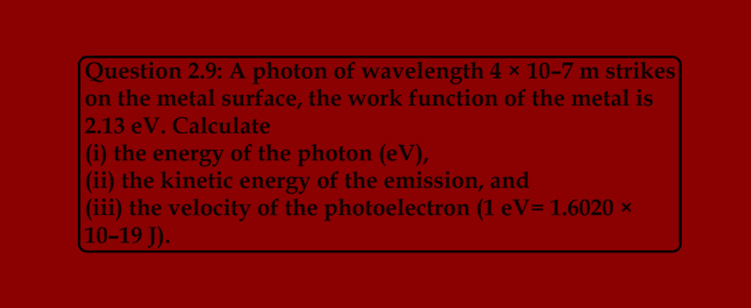Question 2.9: A photon of wavelength 4 × 10–7 m strikes on the metal surface, the work function of the metal is 2.13 eV. Calculate
(i) the energy of the photon (eV),
(ii) the kinetic energy of the emission, and
(iii) the velocity of the photoelectron (1 eV= 1.6020 × 10–19 J).
Question 2.9: A photon of wavelength 4 × 10–7 m strikes on the metal surface, the work function of the metal is 2.13 eV. Calculate
(i) the energy of the photon (eV),
(ii) the kinetic energy of the emission, and
(iii) the velocity of the photoelectron (1 eV= 1.6020 × 10–19 J).
Ans 2.9: (i) We know
Energy (E) of a photon = hν
E = hc/Λ ————-(1) (ν = c/Λ)
Where, h = Planck’s constant = 6.626 × 10–34 Js
c = velocity of light in vacuum = 3 × 108 m/s
λ = wavelength of photon = 4 × 10–7 m
Substituting the values in relation (1)
E = 6.626 × 10–34 Js x 3 × 108 m/s/ 4 × 10–7 m
Hence, the energy of the photon is 4.97 × 10–19 J.
The energy of the photon (eV),
E = 4.97 × 10–19/1.6020 × 10–19 J = 3.10 ev
(ii) The kinetic energy of emission Ek is given by
KE= hν – hν0 ————(2)
But we know E = hν, w0 = hν0
KE = E – w0
KE = 3.10 – 2.13 = 0.97 ev
(iii) The velocity of a photoelectron (ν)
KE = 1/2mv2
KE = 0.97 ev x 1.6020 × 10–19 J
0.97 ev x 1.6020 × 10–19 J = ½ 9.1 x 10-31 kg x v2
We know
1J = Kgm2s-2
On solving
v2 = 34.12 x 1010 m2s-2
v = 5.8 x 105 m/s



